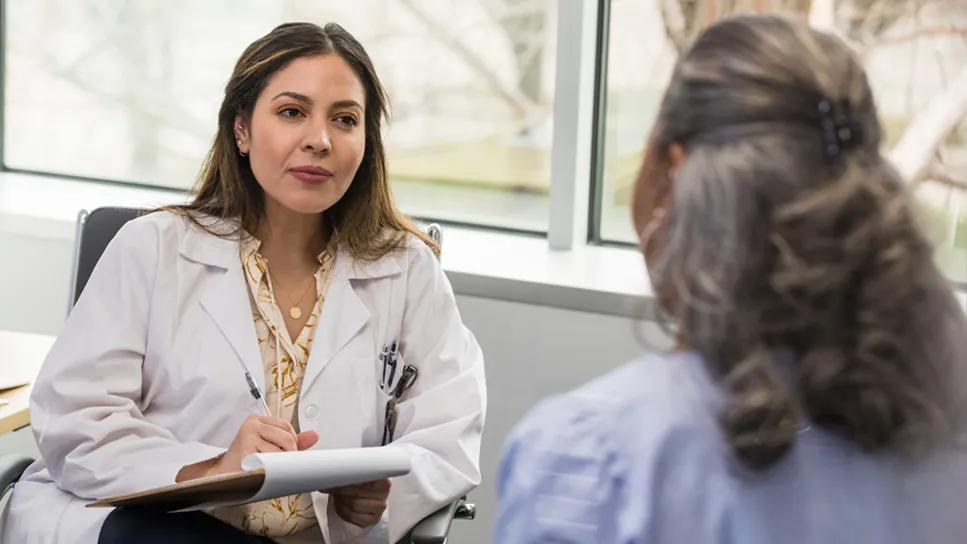Lutheran Hospital team brings emerging treatments to community setting

Language barriers are a key obstacle in delivering cancer care. These barriers also impede efforts at clinical trial recruitment. Nearly one fifth of the U.S. population is Hispanic or Latino. Yet according to the American Association for Cancer Research, 73 percent of the most pivotal cancer clinical trials lacked adequate representation of Hispanic and Latino patients.
Lack of native-language communication means patients often have limited understanding of how best to manage their disease. These communication hurdles also may limit some populations from enrolling in clinical trials. Without proper representation in trials, there’s no way to know whether emerging treatments are effective across populations.
Louis Williams, MD, is one physician seeking to change that. Last year, Dr. Williams and his team created a hematology clinic on the west side of Ohio City designed to include accommodations for Spanish-speaking patients. Dr. Williams treats patients with benign and malignant hematological diseases, such as multiple myeloma. The clinic, which is open to all patients, offers access to advanced therapies, including treatments available through clinical trials.
Advertisement
Cleveland Clinic is a non-profit academic medical center. Advertising on our site helps support our mission. We do not endorse non-Cleveland Clinic products or services. Policy
As a clinician and a linguaphile, Dr. Williams recognized several ways language barriers were obstructing care:
• Lack of communication in patients’ native language left severe knowledge gaps. Even some patients who had been through several lines of treatment arrived at the clinic not knowing much about their disease, the treatment course, the expectations and the prognosis.
“A lot of patients don't receive care in their native language, so they aren't as well-informed about their disease,” says Dr. Williams. "It's not the language barrier in and of itself at the point of care that's the issue. It's the accumulated deficit in knowledge that comes from navigating a medical system in their second language.”
• Interpreter services aren’t enough. Although most health systems offer interpreter services, those aren’t ideal for the level of communication needed for cancer care. While most interpreters are [fully] bilingual, they aren’t medically trained, so they don’t know the vocabulary. What’s more, having a conversation through an interpreter is tremendously cumbersome for the patient and the physician. For example, it’s difficult to ask a compound question in that setting.
“It's tough to develop a personal connection with someone when you're communicating through an interpreter,” says Dr. Williams. “There’s subtlety in how you say things. A lot gets lost in translation, not the direct translation of words but in the ideas you’re seeking to convey.”
• Logistical hurdles make conversations about trial opportunities burdensome. For example, making consent forms for all trials accessible in Spanish, Mandarin and French or Haitian Creole would vastly improve clinical trial access. However, for legal and procedural reasons, there’s a great deal of bureaucracy involved with simply getting a consent form translated.
Beyond that, physicians who are already pressed for time need to explain the rationale, risks and benefits of the trial. When there are language barriers involved, combined with a patient’s limited understanding of the disease, it’s tough to do justice to these conversations.
• Patients need native language support across the board. Bilingual support is important across the healthcare system. “Imagine if the person driving your ambulance, the person wheeling your wheelchair and the person caring for you at the rehab facility don’t speak your language,” says Dr. Williams. “It’s hard just to get to an appointment in that scenario.”
Advertisement
To help address many of these barriers, Dr. Williams and his team decided to create a hematology clinic within the Spanish-speaking community. The location has been an added convenience for patients. The clinic is walkable for some patients and offers free parking [for those who drive].
Patients can now visit the clinic and interact with their physician, as well as schedulers and social workers who all speak Spanish. They can see their hematologist, get consented for a trial in their own language and can have their family there to answer questions in their own language. Currently, the clinic sees roughly 50-75 patients, primarily from the Caribbean, Dominican Republic and Puerto Rico. As the only hematology clinic in Cleveland, it’s experiencing a high demand for its services.
As an integrated clinic, they also offer access to a bilingual (English- and Spanish-speaking) nephrologist, endocrinologist, rheumatologist as well as primary care physicians.
The clinic connects patients with advanced treatments such as CAR T-cell therapy and bispecific antibodies that wouldn’t typically be available at a neighborhood oncology setting. The clinic has opened up chair space at Lutheran Hospital so that patients can receive all their care in one place. It has grown organically, based on word of mouth from fellow patients.
As the clinic continues to build out resources locally, they are seeking ways to streamline the patient experience. “We want to do the absolute best to serve the community. Once we can demonstrate that we’re able to optimize the experience for current patients and make the experience scalable, we’ll consider expanding the model.”
Meanwhile, patients are thankful to have the service. “It feels good to help patients who may have otherwise been overlooked or who didn’t have the opportunity to receive the best care,” says Dr. Williams.
Advertisement
Advertisement

A closer look at training, scholarship and opportunity within this sub subspecialty

A multi-pronged strategy for tackling cancer access problems

Approximately 500 million people globally are experiencing 'period poverty'

Partnerships with local social service agencies key to program success

Findings from large cohort analysis can guide ongoing quality improvement initiatives

For some older adults, a rural setting in late life may be protective

Rates of CR eligibility high and internet access low among older patients in rural areas

Early interventions, improved screening access and tailored support services can help patients navigate cancer care